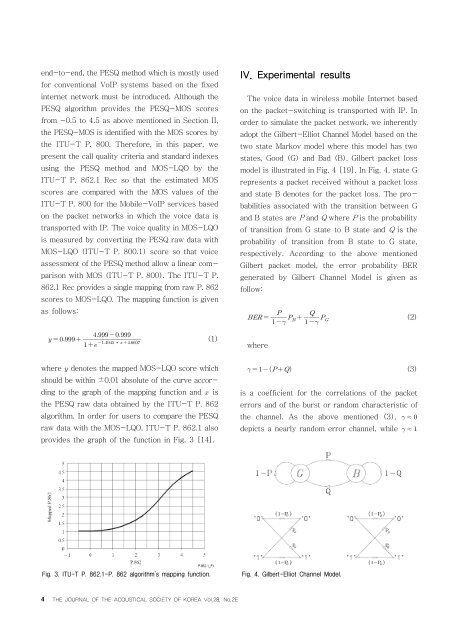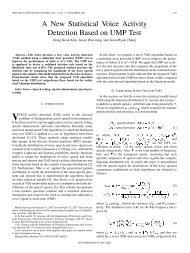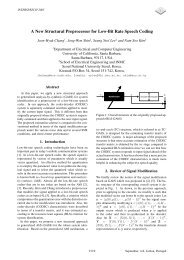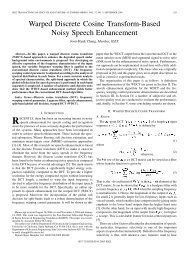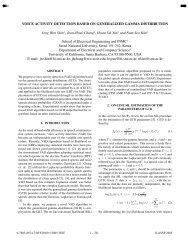A Study on Voice Communication Quality Criteria Under Mobile ...
A Study on Voice Communication Quality Criteria Under Mobile ...
A Study on Voice Communication Quality Criteria Under Mobile ...
Create successful ePaper yourself
Turn your PDF publications into a flip-book with our unique Google optimized e-Paper software.
end-to-end, the PESQ method which is mostly used<br />
for c<strong>on</strong>venti<strong>on</strong>al VoIP systems based <strong>on</strong> the fixed<br />
internet network must be introduced. Although the<br />
PESQ algorithm provides the PESQ-MOS scores<br />
from -0.5 to 4.5 as above menti<strong>on</strong>ed in Secti<strong>on</strong> II,<br />
the PESQ-MOS is identified with the MOS scores by<br />
the ITU-T P. 800. Therefore, in this paper, we<br />
present the call quality criteria and standard indexes<br />
using the PESQ method and MOS-LQO by the<br />
ITU-T P. 862.1 Rec so that the estimated MOS<br />
scores are compared with the MOS values of the<br />
ITU-T P. 800 for the <strong>Mobile</strong>-VoIP services based<br />
<strong>on</strong> the packet networks in which the voice data is<br />
transported with IP. The voice quality in MOS-LQO<br />
is measured by c<strong>on</strong>verting the PESQ raw data with<br />
MOS-LQO (ITU-T P. 800.1) score so that voice<br />
assessment of the PESQ method allow a linear comparis<strong>on</strong><br />
with MOS (ITU-T P. 800). The ITU-T P.<br />
862.1 Rec provides a single mapping from raw P. 862<br />
scores to MOS-LQO. The mapping functi<strong>on</strong> is given<br />
as follows:<br />
IV. Experimental results<br />
The voice data in wireless mobile Internet based<br />
<strong>on</strong> the packet-switching is transported with IP. In<br />
order to simulate the packet network, we inherently<br />
adopt the Gilbert-Elliot Channel Model based <strong>on</strong> the<br />
two state Markov model where this model has two<br />
states, Good (G) and Bad (B). Gilbert packet loss<br />
model is illustrated in Fig. 4 [19]. In Fig. 4, state G<br />
represents a packet received without a packet loss<br />
and state B denotes for the packet loss. The probabilities<br />
associated with the transiti<strong>on</strong> between G<br />
and B states are P and Q where P is the probability<br />
of transiti<strong>on</strong> from G state to B state and Q is the<br />
probability of transiti<strong>on</strong> from B state to G state,<br />
respectively. According to the above menti<strong>on</strong>ed<br />
Gilbert packet model, the error probability BER<br />
generated by Gilbert Channel Model is given as<br />
follow:<br />
<br />
(2)<br />
<br />
<br />
<br />
∙ <br />
(1)<br />
where<br />
where denotes the mapped MOS-LQO score which<br />
should be within ±0.01 absolute of the curve according<br />
to the graph of the mapping functi<strong>on</strong> and is<br />
the PESQ raw data obtained by the ITU-T P. 862<br />
algorithm. In order for users to compare the PESQ<br />
raw data with the MOS-LQO, ITU-T P. 862.1 also<br />
provides the graph of the functi<strong>on</strong> in Fig. 3 [14].<br />
(3)<br />
is a coefficient for the correlati<strong>on</strong>s of the packet<br />
errors and of the burst or random characteristic of<br />
the channel. As the above menti<strong>on</strong>ed (3), ≈<br />
depicts a nearly random error channel, while ≈<br />
Fig. 3. ITU-T P. 862.1-P. 862 algorithm’s mapping functi<strong>on</strong>.<br />
Fig. 4. Gilbert-Elliot Channel Model.<br />
4 THE JOURNAL OF THE ACOUSTICAL SOCIETY OF KOREA Vol.28, No.2E


